As the holidays approach and the light wanes, we’re thankful that there are always natural wonders to experience on these islands, no matter the season. We are also thankful to the knowledgeable naturalists among us who help us uncover our islands’ natural surprises and lead us to seeing our home in a new way. In this post (which first appeared in the Vashon-Maury Island Beachcomber Thanksgiving edition, Nov. 22, 2018), bird expert Ed Swan shares some of his favorite island birding haunts. We hope it inspires you to lace up your boots, grab your binoculars and head out for a post-Thanksgiving adventure to meet some of our local feathered friends.
Many thanks to Vashon-Maury Island Audubon for sharing the beautiful photos in this post from their 2019 calendar, available for purchase at Thriftway customer service and Vashon Bookshop, or order them online. They make great gifts! (Featured photo: A male Wood Duck struts his stuff. Photo by David Waterworth.)
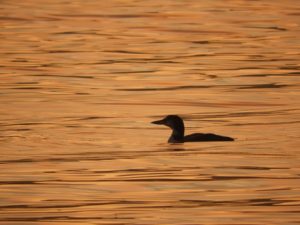
A Common Loon (see how low their bodies sit in the water?) silhouetted against the reflected sunrise. Photo by Sherry Lee Bottoms
Birdwatching Expert Shares Favorite Island Hot Spots
For Birds of Vashon Island author Ed Swan, the island’s diverse habitats and easy access make it a prime location for his
birdwatching tour
business. After living on the island for 15 years, Swan moved to West Seattle three years ago, but he still braves the ferry lines at least once a week to introduce bird lovers to tried-and-true island hot spots.
“Each spot has its own little set of birds and you travel from one to the next in only 5 or 10 minutes and see anywhere from 40 to 60 different species in a few hours,” Swan says. “You can find these birds in Seattle, but you have to fight traffic and share each place with lots of people. On Vashon, it’s a way more pleasant experience.”
North-end Ferry Dock
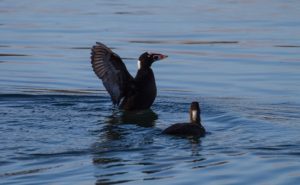
Two male Surf Scoters. Photo by Ann Donahoe.
Swan kicks off his bird tours at the north-end ferry dock, where on a recent trip he tallied 20 species by scanning the water from the small deck next to the county boat ramp. This included an array of seabirds recently returned from northern and eastern breeding grounds to winter in local waters: Surf Scoters; Common Loons; Horned, Eared and Red-necked Grebes; and Buffleheads. One of his personal favorites is the aptly named Harlequin Duck—drawn to wavelets south of the dock, the males sport sharply delineated birght markings in blue, rust, white and black.
This is also a good place to pick out the characteristics that distinguish our three local cormorants. These large, dark birds chase their fish prey by propelling themselves with webbed feet; they nest on cliffs along the Washington Coast. The Double-crested has an orange patch at the base of its bill, the Brandt’s has a tannish bill patch, and the Pelagic is about ¾ the size of the other two with a pencil-thin straight beak and a snaky neck. The Double-crested is the one most likely to roost, wings outstretched, looking like a live Batman insignia.
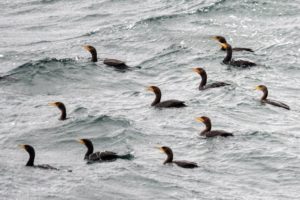
A flock of Double-Crested Cormorants, one of three cormorant species wintering on Vashon-Maury. Photo by Jim Diers.
During his recent visit, Swan was also treated to a falcon flyover.
“A Peregrine powered its way in from the north along the length of the dock and up over the hill, likely looking for starlings or pigeons,” hey says. “They have a distinctive flight pattern with powerful, rapid wing beats like they are run on an engine. They keep a steady, determined pace flying in a straight line.”
Fisher Pond
Next stop on the Swan tour is Fisher Pond, where he urges birders to exit their cars quietly and keep voices low to improve the chances of up-close views of the glorious, seemingly painted-on plumage of our resident Wood Ducks. Take your time here and slowly scan the pond edges and you may also be rewarded with Hooded Mergansers, Green-Winged Teals, Mallards, Northern Shovelers and Ring-necked Ducks. Great Blue Herons hunt in the shallows, and you may see a Bald Eagle eyeing the ducks hungrily from the upper reaches of a madrona. It’s fun to work your way slowly around the trail that follows the western edge of the pond for new vantage points—with each turn you may spy new feathered friends.
Meadowlake Pond—Island Center Forest

“Down the hatch” is a useful mnemonic device to remember that Red-breasted Nuthatches like this one encircle trees in a downward spiral. Photo by Alice Burns.
At this tucked-away island gem, a raised platform affords excellent views of a small yet prolific (species-wise) pond. Between Fisher and this watering hole, Swan often ticks off every duck on his wish list. Common Ravens seem to play King of the Forest on the surrounding snags, and can be seen racing each other over the pond, treating spectators to an array of chortling calls and aerial acrobatics. Keep an eye out for Cooper’s and Sharp-shinned hawks, which zip through the trees in pursuit of their passerine prey (songbirds, or literally: perching birds).
Hold still long enough and you may discern the twitters and chirps of an approaching feeding flock. In fall, passerines of several species group together to ward off and confuse predators like said hawks—insistently scouring trees and bushes for insects, spiders, seeds and berries. Those quiet and watchful enough will be treated to a movable feasting of some combination of Ruby-crowned Kinglets, Brown Creepers (they circle trees in an upward spiral), Red-breasted Nuthatches (they circle trees headfirst in a downward spiral), Bewick’s Wrens, Black-capped and Chestnut-backed Chickadees, Dark-eyed Juncos and Downy Woodpeckers.
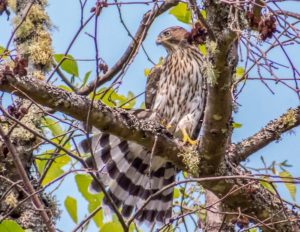
A juvenile Sharp-shinned Hawk fans its tail in the sunshine. Photo by Clara Perez.
Ellisport and Tramp Harbor
Tramp Harbor is a popular gathering spot for a huge flock of birds (700 were reported there recently!), which convivially congregates in the shallows. They are American Widgeons and mixed in among these common winter ducks you may find a rare Eurasian Widgeon, whose mates are now dabbling in Japan, China, India and Europe. Each fall, as Eurasian Widgeons begin their journey south from breeding grounds in Siberia some make a wrong turn, and a difference of only a few degrees of the compass can lead them southeast through Alaska rather than southwest through Asia. Once here, they somehow locate their kissing cousins and provide an eye-spy game for birders who try to pick out the Eurasian males’ telltale brick-red heads among the green-headed Americans.
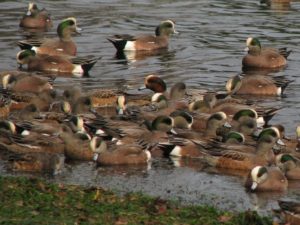
One of these birds is not like the others. Can you spot the Eurasian Wigeon among its American cousins? Photo by Harsi Parker.
At low tide, this beach is a favorite of Mew’s Gulls. Once known as Slender-billed Gulls, they have dainty, thin yellow bills. Smaller than our ubiquitous Glaucus-winged Gulls, they have noticeably black wingtips set off by a white spot at the end of each wing.
From here, it’s an easy jaunt to KVI Beach, where this time of year the estuary pond (south of the radio tower) hosts Green-winged Teal, Mallards and Killdeer. Conspicuous Belted Kingfishers can be recognized by jaunty blue-gray crests and an insistent rattling call. Watch for them to hover and dive for a meal, then land on a branch to gobble it in one silvery swallow.
By this time you may be ready for a snack yourself, and 60 birds or no, it’s always best to quit wanting more—an easy ask on Vashon, where more birds continually beckon.
Become a Better Birder
Vashon-Maury Audubon Education Chair Harsi Parker suggests approaching birding more like signing up for a treasure hunt and less like buying tickets to a movie.
“When you go out to watch birds, you’re not guaranteed the birds you are hoping to find, but you are always guaranteed some wildlife adventure,” she says.
Parker, who co-leads monthly local Audubon field trips has these tips for making the most of a winter birding trip:
- Dress warmly—you spend a lot of time standing still to get a better look at birds and it gets chilly quickly.
- When the tide is high, water birds may feed nearer to shore and allow closer viewing.
- If you have binoculars, bring them. If not, you can always enjoy the movements of the birds feeding, swimming or flying. Try closing your eyes and just listening to their sounds.
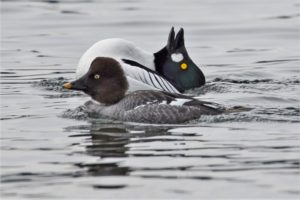
What’s this bird doing? A male Common Goldeneye tries to attract a female’s attention with this courtship display. Does she look impressed? Photo by Jim Diers.
To hone your observation skills, when you find a bird, try to answer these questions:
- What is the main feather color? Other additional colors?
- What feather patterns are visible? (spots, barring, streaks, etc.)
- What shape and color is the bill? What type of feet?
- What is its size relative to a nearby known object? (Bigger than the buoy, smaller than a suet feeder, the same size as a robin?)
- What is the surrounding habitat?
- What sounds is it making?
Birding Resources
General info
Vashon-Maury Island Audubon (Details about birding locations mentioned in this post.)
Vashon Nature Center (Local natural history and community science.)
Cornell Lab of Ornithology (Detailed species accounts including photos and sounds.)
Tours
Email Ed Swan or call him at 206-949-3545. In addition to Vashon, Swan offers birding tours in West Seattle, the Nisqually National Wildlife Refuge, plus Skagit and Whatcom Counties. $35/hour for up to four people; two-hour minimum.
Vashon-Maury Audubon second Saturday bird walk. Free.
Books/Apps
Birds of Vashon Island by Ed Swan
The Sibley Guide to Birds by David Allen Sibley (Swan’s favorite illustrated guidebook.)
Birds of the Pacific Northwest by Tom Aversa, Richard Cannings and Hal Opperman (Swan’s favorite local pocket guidebook with photos and descriptive text.)
Many birders also appreciate the convenience of bird guide apps like iBird Pro, Sibley eGuide to the Birds of North America and Peterson’s Birds of North America.
Christmas Bird Count
Be part of this worldwide bird survey and count birds on the island on Dec. 30. Email CBC coordinator Ezra Parker for details or call him at 206-463-0383.

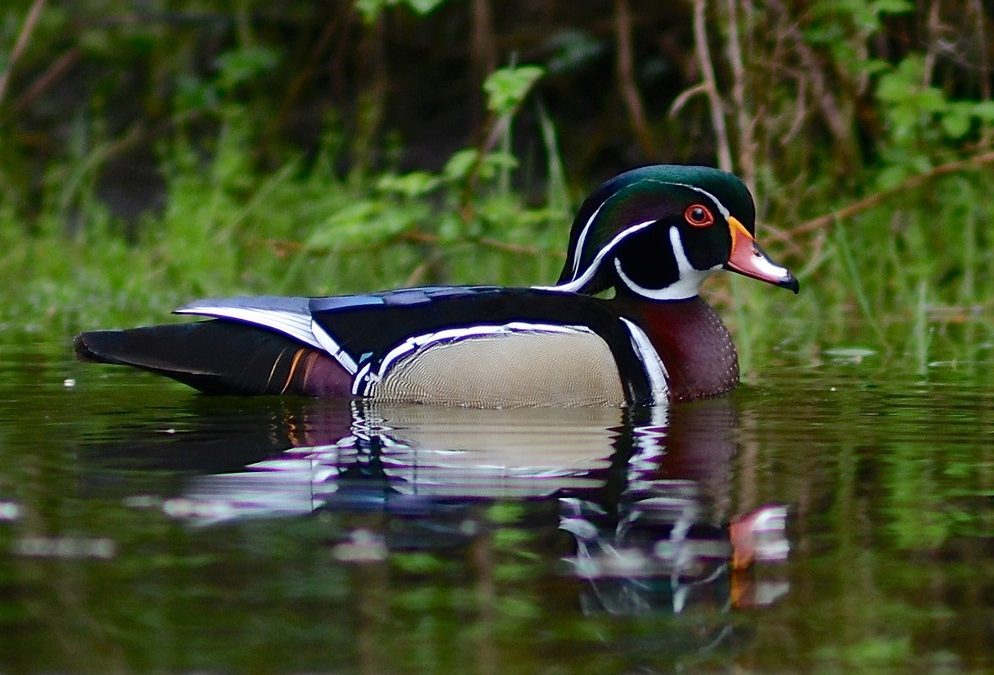
Beautifully written, Kathryn, and I love all the fun tidbits of information about our Island birds.
Thank you, Sarah! I so appreciate all you do to bring the love of birds to islanders and beyond.